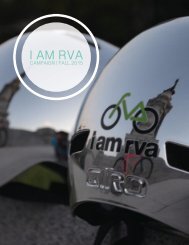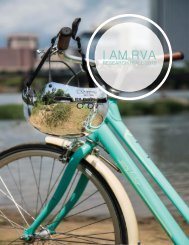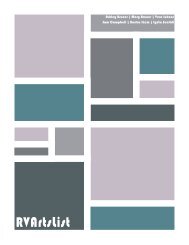You also want an ePaper? Increase the reach of your titles
YUMPU automatically turns print PDFs into web optimized ePapers that Google loves.
key publics<br />
Determining I Am RVA’s key publics is an important step in analyzing the organization.<br />
We determined that I Am RVA has six key publics that warrant attention in a public<br />
relations campaign. After determining the key publics, we conducted research to<br />
determine key characteristics about each group. In this section, we include some<br />
important information about each individual key public. Each of these publics fall under<br />
the main category of the local Richmond community.<br />
cyclists<br />
Cyclists make up one of the key publics most important to I Am RVA. Because I Am<br />
RVA focuses on bike safety, specifically through the production of metallic helmets,<br />
current cyclists are essential to the organization. For this key public, we asked ourselves<br />
two questions to help us better understand this group. Why don’t some cyclists<br />
wear helmets, and why should all cyclists wear helmets?<br />
Why don’t some cyclists wear helmets?<br />
Through our research, we found that there are large groups of cyclists who are<br />
staunchly anti-helmet. We researched the rationale behind this in order to better help I<br />
Am RVA develop <strong>campaigns</strong> to influence this group to practice bike safety.<br />
An article by Bruce Barcott entitled “Senseless” explained some of the thought processes<br />
behind the anti-helmet movement. According to this article, half of all bike riders<br />
were wearing helmets by 1999 (Barcott, 5). Barcott also states that as more riders<br />
used helmets, brain injuries also increased. Below are some key anti-helmet arguments<br />
laid out by Barcott in “Senseless” that explain the rationale used by helmet opponents<br />
(Barcott, 12). By understanding these arguments, we can help I Am RVA better combat<br />
them.<br />
They make motorists complacent. A study done by psychologist Ian Walker found that<br />
motorists drove 3.35 inches closer to him when he wore his helmet.<br />
They increase risky riding. If you trust your helmet to protect you, you may engage in<br />
riskier behavior.<br />
They scare away riders. Helmet laws make the sport seem dangerous.<br />
They diminish bikeshare usage.<br />
12








